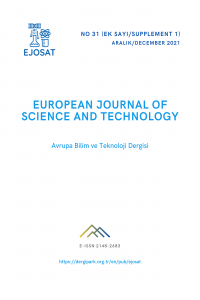Öz
Saldırganlar kurbanlarının kredi kartı, e-posta, sosyal medya hesap bilgileri gibi hassas verileri ele geçirmek için sahte web siteleri tasarlamaktadırlar. Bu saldırılar son zamanlarda daha karmaşık hale gelmiş dikkatli kullanıcıları kolayca kandırabilen oldukça ikna edici tasarımlar geliştirmişlerdir. Giderek daha tehlikeli hale gelen bu soruna çözüm bulmak için yapılan çalışmalar sahte web sayfalarının verileri ile kimlik avı amacı ile hazırlanmış web sayfalarının makine öğrenmesi yöntemi kullanarak tahminini yapabilecek sistemler tasarlanmıştır. Bu çalışmada seçilen örnek web sitesi adresine ait belirlenmiş 6 özellik kullanılarak; bu web site adreslerinin kimlik avı amacı ile hazırlanıp hazırlanmadığı rastgele orman (random forest) algoritması kullanarak tespit edilmeye çalışılmaktadır. Çalışmada seçilen veri seti, Uluslararası Siber Olaylara Müdahale Merkezinin resmi web sitesinde yer alan açık kaynak verileri kullanılmıştır. Toplamda 12.275 adet web sitesi çalışma için değerlendirilmiştir. Veri seti, internet URL ve alan adlarının belirlenen 6 özelliğin kategorilendirilmesi ve etiketlenmesi ile oluşturulmuştur. Etiketler (Kimlik avı=1, Şüpheli=0, Meşru=-1) python dilinde geliştirilmiş betikler ve tablolama programlarından yararlanılarak belirlenmiştir. Çalışma sonucunda kullanılan yöntem 95% başarı performansı göstermiştir.
Anahtar Kelimeler
Web Sitesi Özellikleri Kimlik Avı Özellik Çıkarma Makine Öğrenmesi
Kaynakça
- CNN | Phishing scams reel in your identity, CNN. [Çevrimiçi]. https://edition.cnn.com/2003/TECH/internet/07/21/phishing.scam/index.html [Erişim: 27-Eylül-2021].
- Keepnetlabs | 2020 phishing statistics, Keepnetlabs. [Çevrimiçi]. https://www.keepnetlabs.com/phishing-statistics-you-need-to-know-to-protect-your-organization/#easy-footnote-bottom-3-3791 [Erişim: 19-Eylül-2021].
- Verizon | 2020 Summary of Findings, Verizon. [Çevrimiçi]. https://enterprise.verizon.com/resources/reports/dbir/2020/summary-of-findings/ [Erişim: 6-Ekim-2021].
- Bhardwaj, A., Sapra, V., Kumar, A., Kumar, N., & Arthi, S. (2020). Why is phishing still successful?. Computer Fraud & Security, 2020(9), 15-19.
- Ometov, A., Bezzateev, S., Mäkitalo, N., Andreev, S., Mikkonen, T., & Koucheryavy, Y. (2018). Multi-factor authentication: A survey. Cryptography, 2(1), 1.
- Apandi, Siti & Sallim, Jamaludin & Sidek, Roslina. (2020). Types of anti-phishing solutions for phishing attack. IOP Conference Series: Materials Science and Engineering. 769. 012072. 10.1088/1757-899X/769/1/012072. M. Young, The Technical Writer’s Handbook. Mill Valley, CA: University Science, 1989.
- Al-Ahmadi, S. (2020). A Deep Learning Technique for Web Phishing Detection Combined URL Features and Visual Similarity. International Journal of Computer Networks & Communications (IJCNC) Vol, 12.
- Awasthi, A., & Goel, N. (2021). Phishing Website Prediction: A Machine Learning Approach. In Progress in Advanced Computing and Intelligent Engineering (pp. 143-152). Springer, Singapore.
- Hema, R., Ramya, V., Sahithya, K., & Sekharan, R. (2020). Detecting of Phishing Websites using Deep Learning. Journal of Critical Reviews, 7(11), 3606-3613.
- Hossain, S., Sarma, D., & Chakma, R. J. (2020). Machine Learning-Based Phishing Attack Detection. Machine Learning, 11(9).
- Hatwell, J., Gaber, M. M., & Azad, R. M. A. (2020). CHIRPS: Explaining random forest classification. Artificial Intelligence Review, 53, 5747-5788.
- Xue, M., Yuan, C., Wu, H., Zhang, Y., & Liu, W. (2020). Machine learning security: Threats, countermeasures, and evaluations. IEEE Access, 8, 74720-74742.
Öz
Attackers are designing fake websites to collect sensitive data such as credit card, email, social media account information of their victims. These attacks keep getting more sophisticated day by day. This leads to highly convincing website designs that can easily trick users and steal their information. In order to prevent this increasingly dangerous problem from spreading, systems with machine learning capabilities have been developed to predict if a web page or web site is created exclusively for phishing or not. In this study, using the determined 6 features of the selected sample website address 12.275. It is tried to determine whether this website address is prepared for phishing purposes or not by using a random forest algorithm. The selected data set in this study have been collected from open-source datas which is published on the official website of the Computer Emergency Response Team of Turkey. The data set was created by categorizing and labeling internet urls and domain names according to 6 determined features. Tags (Phishing=1, Suspect=0, Legitimate=-1) were determined using scripts and tabulation programs developed on python programming language. As a conclusion of the study, used method has shown 95 % success performance.
Anahtar Kelimeler
Website Features Phishing Feature Extraction Machine Learning. Website Features, Phishing, Feature Extraction, Machine Learning
Kaynakça
- CNN | Phishing scams reel in your identity, CNN. [Çevrimiçi]. https://edition.cnn.com/2003/TECH/internet/07/21/phishing.scam/index.html [Erişim: 27-Eylül-2021].
- Keepnetlabs | 2020 phishing statistics, Keepnetlabs. [Çevrimiçi]. https://www.keepnetlabs.com/phishing-statistics-you-need-to-know-to-protect-your-organization/#easy-footnote-bottom-3-3791 [Erişim: 19-Eylül-2021].
- Verizon | 2020 Summary of Findings, Verizon. [Çevrimiçi]. https://enterprise.verizon.com/resources/reports/dbir/2020/summary-of-findings/ [Erişim: 6-Ekim-2021].
- Bhardwaj, A., Sapra, V., Kumar, A., Kumar, N., & Arthi, S. (2020). Why is phishing still successful?. Computer Fraud & Security, 2020(9), 15-19.
- Ometov, A., Bezzateev, S., Mäkitalo, N., Andreev, S., Mikkonen, T., & Koucheryavy, Y. (2018). Multi-factor authentication: A survey. Cryptography, 2(1), 1.
- Apandi, Siti & Sallim, Jamaludin & Sidek, Roslina. (2020). Types of anti-phishing solutions for phishing attack. IOP Conference Series: Materials Science and Engineering. 769. 012072. 10.1088/1757-899X/769/1/012072. M. Young, The Technical Writer’s Handbook. Mill Valley, CA: University Science, 1989.
- Al-Ahmadi, S. (2020). A Deep Learning Technique for Web Phishing Detection Combined URL Features and Visual Similarity. International Journal of Computer Networks & Communications (IJCNC) Vol, 12.
- Awasthi, A., & Goel, N. (2021). Phishing Website Prediction: A Machine Learning Approach. In Progress in Advanced Computing and Intelligent Engineering (pp. 143-152). Springer, Singapore.
- Hema, R., Ramya, V., Sahithya, K., & Sekharan, R. (2020). Detecting of Phishing Websites using Deep Learning. Journal of Critical Reviews, 7(11), 3606-3613.
- Hossain, S., Sarma, D., & Chakma, R. J. (2020). Machine Learning-Based Phishing Attack Detection. Machine Learning, 11(9).
- Hatwell, J., Gaber, M. M., & Azad, R. M. A. (2020). CHIRPS: Explaining random forest classification. Artificial Intelligence Review, 53, 5747-5788.
- Xue, M., Yuan, C., Wu, H., Zhang, Y., & Liu, W. (2020). Machine learning security: Threats, countermeasures, and evaluations. IEEE Access, 8, 74720-74742.
Ayrıntılar
| Birincil Dil | Türkçe |
|---|---|
| Konular | Mühendislik |
| Bölüm | Makaleler |
| Yazarlar | |
| Yayımlanma Tarihi | 31 Aralık 2021 |
| Yayımlandığı Sayı | Yıl 2021 Sayı: 31 |

